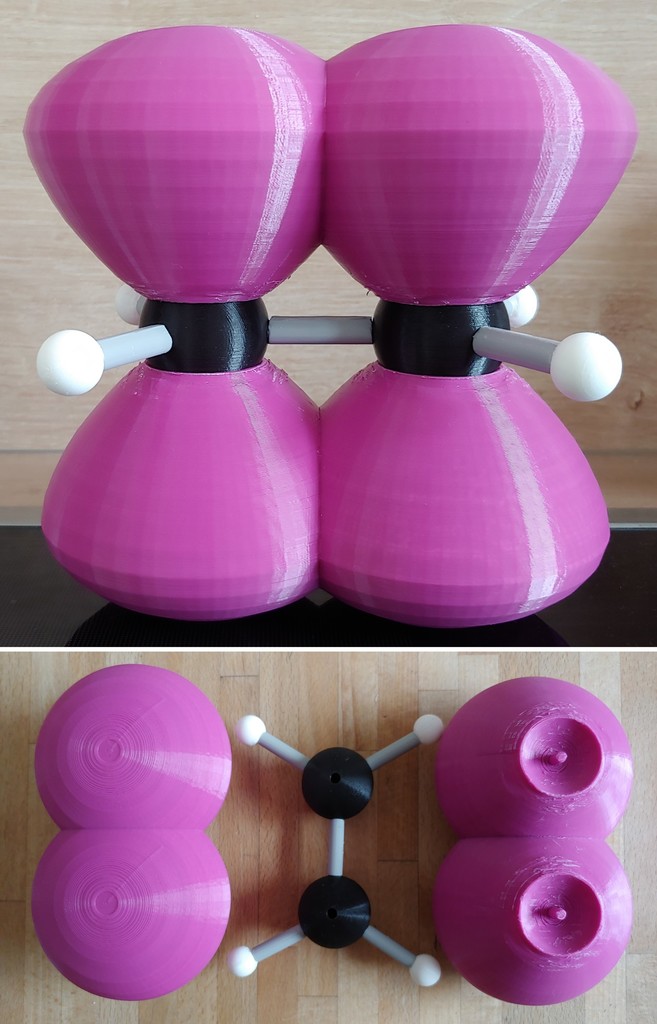
Ethene model (ethylene, ethen, ethylen)
thingiverse
Scroll down for english Ethen-Modell Zum Verständnis von Reaktionen von Alkenen fehlt es manchen Schülerinnen und Schülern an räumlichen Vorstellungsvermögen über die Verteilung von Ladungen / Elektronen in Aliphaten. Das vorliegende Modell versucht daher, die Besonderheiten des Ethen-Moleküls zu visualisieren: Einerseits das sigma-Bindungsgerüst der Kohlenstoff- und Wasserstoffatome und schließlich natürlich die sog. pi-Bindung aus fusionierten p-Orbitalen der sp2-hybridisierten Kohlenstoffatome. Damit können besonders die Neigung zur Reaktion mit Elektrophilen deutlich gemacht werden, weiterhin die verkürzte C-C—Bindungslänge im Vergleich zum Ethan und die unfähigkeit zur Rotation der Kohlenstoffatome um die sigma-Bindugsachse (was schließlich zur cis/trans-Isomerie führt). Das Modell ist maßstabsgetreu. Im gleichen Maßstab finden Sie von mir auch Ethan, Ethin und Benzol auf Thingiverse. Aufgrund ihrer Größe eignen sich die Modelle auch zur Demonstration. Vorausgesetzte Daten --> umgesetzt im Modell zu Bindungslängen C-C-Bindungslänge 133.9 pm --> 66,95 mm C-H-Bindungslänge 108,7 pm --> 54,35 mm HCH-Bindungswinkel 117° --> 117° Kovalenzradien Kohlenstoff 76 pm --> 38 mm Wasserstoff 32 pm --> 16 mm Anleitung: Da viele 3D-Drucker nicht genau maßhaltig sind, habe ich bei den Bauteilen Toleranzen eingeplant. Wenn Ihr Drucker sehr genau druckt, können die Teile beim Zusammenstecken wacklig sein. Generell sollten aber (die meisten) Teile miteinander verklebt werden. Dann wackelt auch nichts mehr. Drucken Sie Ethen_Carbon 2x mit 0.1mm Schichtdicke in schwarz Ethen_CC-Bond 1x mit 0.1mm Schichtdicke in grau Ethen_CC-Links 2x mit 0.1mm Schichtdicke in grau Ethen_CH-Bond 4x mit 0.1mm Schichtdicke in grau Ethen_CH-Links 8x mit 0.1mm Schichtdicke in grau Ethen_pi_merged 2x mit 0.2mm Schichtdicke in lila Ethen_Hydrogen 4x mit 0.1mm Schichtdicke in weiß Verkleben Sie Bindungen, Atome und Stifte zunächst wie auf Abb.1. Durch die Form der Stifte können die Bindungen nicht falsch angebracht werden. Verkleben Sie dann die beiden Kohlenstoffatome über die CC-Bindung. Die sollten Sie machen, während die Kohlenstoffatome auf einem Teil der pi-Bindung stecken. (Abb. 3) Bei vielen 3D-Drucker ist der Druck nicht maßhaltig genug und es könnte sonst passieren, dass die pi-Bindung nicht auf das sigma-Bindungsgerüst passt. Verkleben Sie dann die C-H-Bindunge mit den Kohlenstoffatomen. Sie können abschließen die beiden Teile der pi-Bindung mit dem sigma-Bindungsgerüst verkleben. Ich habe das nicht getan. Das Modell hält so schon sehr gut und wenn sie das pi-Bindung nicht vekleben, können Sie, wenn angebracht, das sigma-Bindungssystem herausnehmen, z. B. um die Bindungslängen mit anderen Modellen (Ethan / Ethin / Benzol) zu vergleichen. Ethene model (Ethylene) To understand the reactions of alkenes, some students lack the spatial imagination of the distribution of charges / electrons in aliphatics. The present model therefore tries to visualize the peculiarities of the ethene molecule: On the one hand, the sigma bond structure of the carbon and hydrogen atoms and, of course, the so-called pi bond from fused p orbitals of the sp2-hybridized carbon atoms. This particularly shows the tendency to react with electrophiles, the shortened C-C bond length compared to ethane and the inability to rotate the carbon atoms around the sigma bond axis (which ultimately leads to cis / trans isomerism). The model is true to scale. On the same scale, you can also find ethane, ethyne (acetylene) and benzene from me on Thingiverse. Due to their size, the models are also suitable for demonstration. Assumed data --> implemented in the model to Bond lengths C-C bond length 133.9 pm --> 66,95 mm C-H bond length 108,7 pm --> 54,35 mm HCH bond angle 117 ° --> 117 ° Covalent radii Carbon 76 pm --> 38 mm Hydrogen 32 pm -->16 mm Instructions: Since many 3D printers are not exactly dimensionally accurate, I have planned tolerances for the components. If your printer prints very accurately, the parts can be wobbly when you put them together. In general, however, (most) parts should be glued together. Then nothing wobbles either. Print Ethen_Carbon 2x with 0.1mm layer thickness in black Ethen_CC-Bond 1x with 0.1mm layer thickness in gray Ethen_CC-Links 2x with 0.1mm layer thickness in gray Ethen_CH-Bond 4x with 0.1mm layer thickness in gray Ethen_CH-Links 8x with 0.1mm layer thickness in gray Ethen_pi_merged 2x with 0.2mm layer thickness in purple Ethen_Hydrogen 4x with 0.1mm layer thickness in white First glue bonds, atoms and pins as shown in Figure 1. The shape of the pins prevents the bindings from being incorrectly attached. Then bond the two carbon atoms through the CC bond. You should do this while the carbon atoms are on the pi bond. (Fig. 3) With many 3D printers, the print is not dimensionally accurate and it could otherwise happen that the pi-binding does not fit on the sigma-binding structure. Then glue the C-H bonds to the carbon atoms. You can then glue the two parts of the pi-bond to the sigma-bond framework. I didn't do that. The model already holds very well and if you do not glue the pi-binding, you can, if appropriate, remove the sigma-binding system, e.g. B. to compare the bond lengths with other models (ethane / ethyne / benzene).
With this file you will be able to print Ethene model (ethylene, ethen, ethylen) with your 3D printer. Click on the button and save the file on your computer to work, edit or customize your design. You can also find more 3D designs for printers on Ethene model (ethylene, ethen, ethylen).
